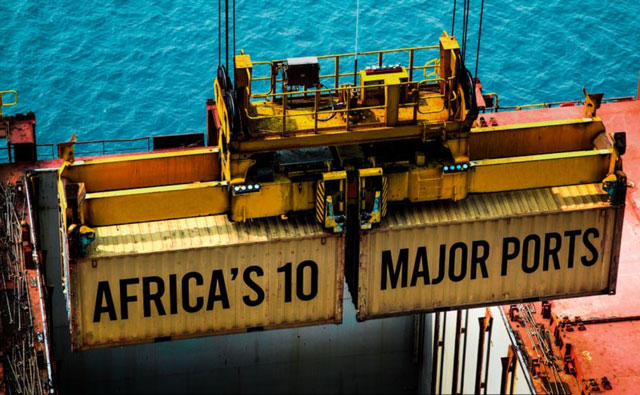
A multi-billion port expansion spree is adding capacity and improving efficiency as African ports race for a bigger slice of the global maritime trade pie. Here, bird story agency lists ten of the most important African ports, in its latest bird’s TenX.
SPECIAL REPORT | BIRD AGENCY | The opening of Nigeria’s ‘game-changing’ billion-dollar deepwater seaport in Lekki, in early 2023, together with other ongoing and upcoming projects around the continent reflects an increasingly competitive race for the top shipping hub slots in Africa.
Currently, a host of other major multi-billion dollar investments geared towards improving existing infrastructure or putting up new ports are ongoing in countries including South Africa, Morocco, Algeria, Angola, Egypt and Senegal.
Among the largest investments announced so far is the US$7 billion to upgrade to the South African Port of Durban in a facelift that will expand its container handling capacity from 2.9 million units to 11 million.
According to the African Union, more than 90% of Africa’s imports and exports are transported by sea, making the continent a strategic gateway to global trade. UNCTAD data shows Africa accounts for 2.5% of exports and 3% of imports in world merchandise trade by value by 2020. An ‘Africa ports race’ that started in the 1990s is expected to significantly bolster the continent’s maritime trade.
Here, bird ranks some of Africa’s major ports, based on the volume they can handle, and their efficiency:
Tanger Med: This is Morocco’s – and Africa’s – biggest port. It has an annual handling capacity of 9 million 20-foot containers (TEUs), exports of 1 million new vehicles and transit of 7 million passengers and 700,000 trucks annually. World Bank and Standard and Poor’s Global Market Intelligence, have ranked it sixth globally in terms of port efficiency with infrastructure that outperforms both African and European ports.
Port Said: The world’s largest coal-bunkering station by the late 19th century, this port is now the busiest in Egypt, with a handling capacity of about 5 million tonnes of 20-feet containers annually. Globally, it is ranked 15th on performance based on port calls and vessels.
Port of Durban: Currently suffering from huge efficiency challenges, Durban is the largest and busiest shipping terminal in southern Africa with a container handling capacity of 2.9 million TEUs and capacity to handle over 600,000 shipped vehicle units. More than 5,000 ships dock at the port every year, generating around 60% of trade revenue for South Africa. A contract to upgrade and manage the container port was recently signed with Philippines-based International Container Terminal Services Inc.
Lekki Deep Sea Port: This newly expanded port is now Nigeria’s first deepwater seaport and one of the biggest in West Africa. It can handle 2.7 million, 20-foot TEU’s and is designed to handle vessels with a capacity exceeding 18,000 TEUs.
Port of Ngqura: This is a South African deep-water container port strategically positioned within a Special Economic Zone (SEZ), with a handling capacity of about 2 million TEUs. It has the longest (2.7 km in length) breakwater in South Africa.
Port of Abidjan: After adding a second container terminal in December 2022, Côte d’Ivoire’s main port increased its total container handling capacity to 2.5 million TEUs per year. Previously, its capacity was 1 million containers.
Port of Casablanca: With a handling capacity of about 1.3 million TEUs, this is one of the largest artificial ports in the world. The Moroccan port can handle 21.3 million tons of cargo annually.
Mombasa: Known for over a century as the main gateway to East Africa, Kenya’s harbour in Mombasa has a handling capacity of 1.65 million containers. It comprises of four ports: Port Reitz, Old Port, Kilindini and Port Tudor. It’s “gateway” title is increasingly being challenged in the region by Tanzania’s Dar es Salaam.
Port of Doraleh: This multi-purpose port in Djibouti, with a capacity to handle 1.6 million containers annually, links Europe, the Far East, the Horn of Africa and the Persian Gulf. A 2020 World Bank and IHS Markit’s latest global Container Port Performance Index recognised Djibouti as the top container port in Africa and 61st globally on efficiency. A new railway links the port with landlocked Ethiopia.
Tema Port: Ghana’s busiest port accounts for 70% of the country’s major container and port-handling traffic. It recently added a new terminal that accommodates vessels of up to 22, 000 TEUs, from a previous 5, 000 TEUs. The new terminal also increases Ghana’s container-handling capacity to around 3.7 million TEUs a year, from 800, 000 TEUs.
****
SOURCE: Conrad Onyango, bird story agency
 The Independent Uganda: You get the Truth we Pay the Price
The Independent Uganda: You get the Truth we Pay the Price


